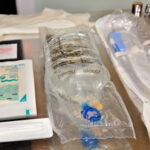You may think it is just you, your spouse, the kids, and the family dog living in your home. But, if you think that, then you are thinking wrong. death Most all homes and other places where food is present have pathogenic germs, viruses, etc living in their home, on their skin, in their nose, their humidifiers, and many cracks and crevices. Scared yet?
Let me continue, these commonly found pathogenic germs can wreak havoc on your immune system, you can pass the pathogenic germs on to others, and some can even cause (especially those with immune deficiency disorders and the elderly). But, there is a plus side to all of this; you can drastically decrease the chances of you or anyone in your home from getting sick due to these common germs by properly sanitizing your home and being knowledgeable of where these common household pathogenic germs live in your home or on your body.
Top Germs in Your Home
Staphylococcus
Staphylococcus is one of the main germs in your home that is pathogenic. In fact, staphylococcus is the most common strand of staph and is a popular cause of food poisoning. Staphylococcus is generally passed by skin-to-skin contact. Certain skin conditions containing this pathogenic are impetigo. Impetigo is incredibly contagious and if anyone in your home is suffering from impetigo, be sure that other family members do not come into skin-to-skin contact with infected person. If you must, use gloves when handling the affected areas, etc.
Streptococcus
The most common type of pathogenic streptococcus includes strep throat, meningitis, bacterial pneumonia, endocarditic, erysipelas, and necrotizing fasciitis.
Streptococcus has many strains including S. pneumonia which can cause bacterial pneumonia and strains can also cause otitis media, meningitis, peritonitis, and sinusitis.
Bacillus
If you are using a humidifier in your home for various reasons that may include aiding in moisturizing the air for people in your home with breathing disorders, you need to be sure to change the water often, check the filter, sanitize the humidifier, and possibly purchase a test to ensure that your humidifier does not have bacillus. A humidifier with bacillus can cause horrible lung infections and usually the severity of the symptom correlates with the amount of exposure to the humidifier containing the pathogen bacillus.
The condition associated with humidifiers containing the bacillus is called Humidifier Lung. The common symptoms of Humidifier Lung include but are not limited to: lung infection, hypersensitivity pneumonititus, impaired lung function, shortness of breath, and fatigue.
Escherichia Coli aka E. Coli
Not all strains of E.Coli are dangerous; in fact, the majorities of the strains of this pathogen are healthy for you or at least are not threatening to a person.
The most common strains of E.Coli we hear of the most are from fecal matter being exposed to the foods we eat.Many recalls of food have been recalled due to E.Coli and this can usually be caused by food handlers not washing their hands after using the rest room.
Salmonella
Salmonella is a bacterium that is the most common cause of food borne illness. The way that salmonella is brought into your home and turned into a ticking time bomb for you or one of your family members to be exposed to the salmonella is due to being unsanitary with raw meats and poultry. This is one of the most common causes of salmonella in the home, but is not the only way salmonella is spread. Children playing with reptiles can also cause salmonella to spread to the childs hand, and from his hand to the door knob, and so on.
All of these pathogenic germs are often found in even the most clean of homes. Sometimes things are overlooked or the house may appear clean, but the invisible to the eye germs are lurking everywhere.
Common Places for Germs in Your Home
Don’t freak out when I tell you this, but if you leave your toothbrush on your bathroom sink…then you are PROBABLY brushing your teeth with the fecal matter that is sprayed out of the toilet with every flush. The best place to keep your toothbrush is as far away from the toilet as possible, possible leave your toothbrush soaking in a solution of hydrogen peroxide after each brushing, or getting caps to go over your toothbrush.
Your remote control, computer keyboard and mouse, door knobs, light switches, and other heavily used surfaces in your home are probably crawling with one or more of the above pathogenic germs.
What Will These Germs Cause
These types of pathogenic germs may be common but the problems they can cause are not common illnesses you want to have. The main types of symptoms you will get after being exposed to these germs include diarrhea, abdominal cramps, and fever. You might not notice the side effects of the symptoms for 8 to 72 hours after you have been exposed to the pathogen. For many people they only suffer from the dreaded “24 Hour Bug” while others take months for their digestive systems to get back on the right track after exposure to these germs.
How Do I Get Rid of the Germs in My Home
You won’t be able to get rid of ALL the germs in your home, but you can greatly reduce them and protect yourself and others from unknown amounts of illnesses that can be caused by exposure to these pathogenic germs. The number one thing to do is wash your hands frequently and be sure to change the hand towels in your bathroom often. Use an antimicrobial hand cleanser as often as possible. Another good idea is to use two separate cutting boards. One cutting boards to be used only for cutting meats and the other board just for cutting up non-animal items such as fruits and vegetables.
Another good idea is to go through the home a few times a week and spray down the most used fixtures in your home with disinfectant sprays.
No matter how hard you try to get your home as germ free as possible, germs will always be in your home. Keep in mind that not all germs are bad and being exposed to some germs is actually healthy for you and will increase your immune system by making it stronger.
Sources:
www.wikipedia.com
www.cdc.gov






